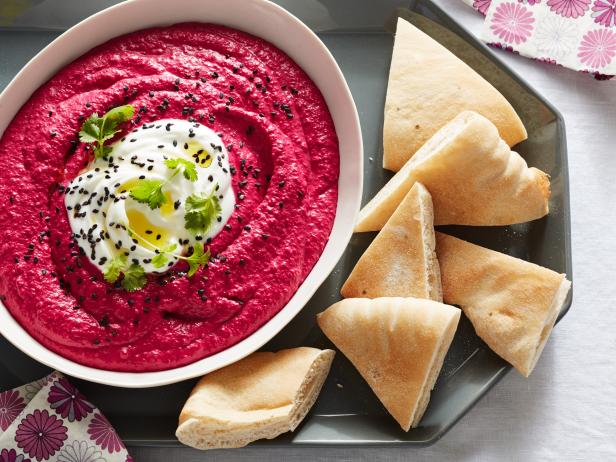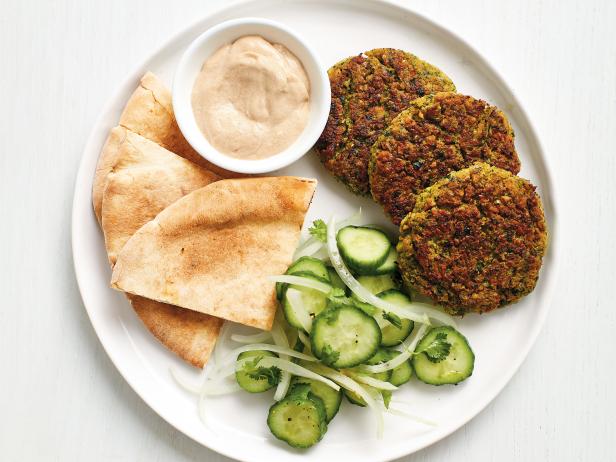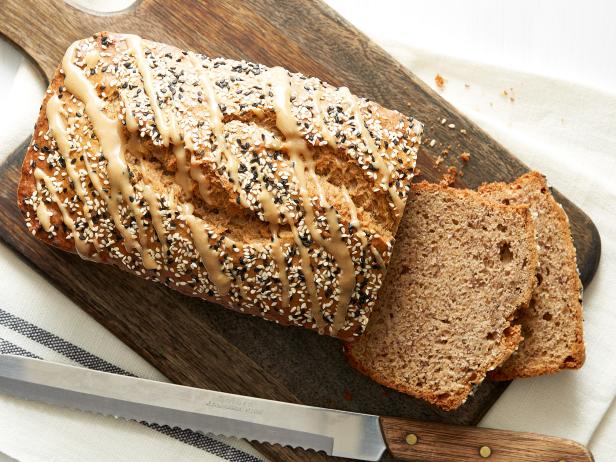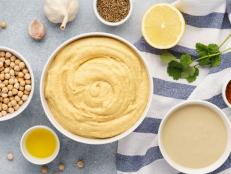What Is Tahini?
Plus how to make tahini from scratch.

SMarina/Getty Images
By Layla Khoury-Hanold for Food Network Kitchen
Layla Khoury-Hanold is a contributor at Food Network.
If you’ve made hummus, you know that tahini is a key ingredient. If you’re more of a baker, you might have noticed tahini showing up in a lot of banana bread and chocolate chip cookie recipes. Or maybe you’ve seen tahini drizzled on the falafel sandwich from your favorite Middle Eastern restaurant. But what is tahini? Here, we cover all your tahini-related questions, from what it tastes like to how to make your own. We’ve also shared our favorite recipes with tahini, on both the sweet and savory sides.

Tatiana Atamaniuk/Getty Images
What Is Tahini?
Tahini, sometimes called tahina, is a ground sesame butter or paste that’s traditionally used in Middle Eastern cuisine. It takes a starring turn in dips such as hummus and baba ghanoush, gets drizzled on falafel sandwiches, or is made into tarator, a tahini-lemon-garlic sauce to accompany fish, vegetables or shawarma. Tahini is also found in the culinary traditions of North African, Levant and the East Mediterranean, and South Caucus countries.
In addition to savory dishes, tahini also lends itself to sweets, particularly halva, a sesame-based confection with a crumbly-meets-fudgy texture. In Lebanon, tahini is combined with carob molasses to make a dessert called dibs bi tahini (though maple syrup or honey can be subbed, too). In the U.S., tahini is gaining traction as a baking ingredient, bringing its creamy texture and subtly nutty flavor to banana bread, cookies and tarts, and as an emulsifier for dressings and dips.
What Is Tahini Made Of?
Tahini is made of three ingredients: hulled sesame seeds, oil and sometimes salt. Hulled sesame seeds are typically toasted then ground and emulsified with oil to create a smooth, creamy seed butter with a pourable consistency.
What Does Tahini Taste Like?
Tahini has an earthy, savory taste; toasting the seeds before grinding them brings out more of their natural nuttiness and reduces some of their bitterness.
Is Tahini Vegan?
As long as the oil used to blend with the sesame seeds is vegan, tahini is vegan. It works wonders in vegan recipes to bring a dairy-free creamy component to sauces in dishes such as Sesame Noodle Salad or Carrot Tart with Cashew-Tahini Sauce (swap in vegan-friendly puff pastry and omit the egg to make it completely vegan). It can even anchor party appetizers such as this Vegan Cheddar Wheel or keep vegan desserts moist and flavorful, as with these Vegan Chocolate Lava Cakes. Since tahini is made from sesame seeds, it’s also a good alternative to nut butters for those with nut allergies, too.
What Is a Good Substitute for Tahini?
Cashew or almond butter are solid substitutes for tahini in most dressing and dip recipes. Creamy peanut butter can also be used, but make sure you use a natural, unsweetened brand. Sunflower seed butter serves as a good nut-free option. If you’re making hummus but don’t have other nut- or seed-butters on hand, sesame seeds and/or sesame oil can also be used as a tahini substitute.

Andrey Zhuravlev/Getty Images
How to Make Tahini
Homemade tahini is a cinch to make in a food processor or high-speed blender.
Tahini-Making Tools
Homemade Tahini
Head over here for a full recipe.
Ingredients to Make Homemade Tahini
- 2 cups hulled sesame seeds. Hulled sesame seeds will produce the creamiest consistency. They are lighter in color than un-hulled sesame seeds, which still have their dark outer shell intact. You can still make tahini with un-hulled sesame seeds, but it tends to produce a slightly more bitter tasting tahini. Sprouted sesame seeds can also be used.
- 3 tablespoons plus 1 1/2 teaspoons vegetable oil, plus more if needed. Avocado oil, grape seed oil, vegetable oil, canola oil or a lighter, fruitier olive oil all work well. Tahini can be made without oil, but it takes longer to grind the sesame seeds and the finished product won’t have as creamy a texture.
- Salt (optional). Salt augments the flavor of the finished product tahini.
Instructions
- Toast the sesame seeds. Spread them out in a single layer in a large, dry skillet over medium-low heat and stir constantly, until they are light in color and start to release their oils and you can smell a roasted, nutty aroma, 3 to 5 minutes. Keep a close eye; sesame seeds are quite small and can burn easily. Transfer the seeds to a large plate or platter and allow them to cool.
- Process the sesame seeds. Transfer the sesame seeds to the bowl of a food processor and process on low speed until the seeds reach a crumbly texture that resembles wet sand, about 2 minutes. Alternatively, you can process the sesame seeds in a high-speed blender (but note that you’ll likely need to scrape down the sides more frequently to ensure the ingredients get fully incorporated).
- Add oil to the sesame seed paste. With the food processor running on low, pour 3 tablespoons of oil through the pour spout, stopping the food processor to scrape down the sides of the bowl with a spatula from time to time. Process for about 3 minutes, until the mixture is smooth. If the mixture looks dry, add 1 more tablespoon of oil and process for 1 minute, until it achieves a pourable, creamy consistency.
- Season with salt to taste. Taste the tahini and add a pinch of salt if desired, then process for a few seconds to incorporate.

Veliavik/Getty Images
How to Store Tahini
Unopened containers of store-bought tahini can be stored in a cool, dry place such as your cupboard or pantry, out of direct sunlight and away from heat sources. Check the manufacturer’s label for the best sell-by date.
Opened containers of store-bought tahini can be stored in either the refrigerator or a cool, dry place out of direct sunlight and away from heat sources. When in doubt, check the manufacturer’s label for storage instructions. You can tell if the tahini has gone bad if it has a rancid or “off” smell or taste.
If you use tahini frequently and plan to use it within 1 month, you can store opened containers of tahini in a cool, dry place away from heat and sunlight.
Refrigerating tahini will extend its shelf life; if you don’t plan to use the whole jar within a few weeks of opening, it’s best to stash it in the fridge, where it will last for up to 6 months. Additionally, homemade tahini should be stored in the refrigerator in an airtight food storage container or lidded jar. It’ll last for up to 1 month in the refrigerator. If the oil separates from the solids, simply stir it back in. Also note that tahini stored in the refrigerator might solidify into a paste-like texture. Simply bring to room temperature prior to using.
Recipes with Tahini
Tahini plays equally well in savory and sweet recipes. In savory recipes, tahini makes an excellent base for dips; sauces for scene-stealing sides such as Blistered Green Beans with Tahini or Bulgur Lentil Pilaf with Tahini-Herb Sauce; and dressings to punch up dishes such as Roasted Veggie Grain Bowls.
On the sweet side, tahini brings a subtle nutty, sesame flavor to baked goods such as banana bread and cookies. Its rich oil content helps keep baked goods moist, too. Like peanut butter, tahini pairs well with jam and chocolate, so try riffing on your favorite sandwich, chocolate and cookie recipes (we’re especially a fan of these Sesame and Jam Sandwich Cookies.)
Here are our favorite recipes with tahini.

Kate Mathis
Tahini is a key player in this iconic dip, but the addition of beets takes things next level. Sweet-earthy beets are the perfect counterpoint to tahini’s nutty flavor, while labneh amplifies tahini’s creaminess. Try making this for your next potluck picnic or holiday party.

RYAN DAUSCH
Tahini is one of falafel’s favorite sidekicks, and this easy baked falafel recipe is the perfect way to sample tahini in a simple, yet flavorful sauce. Simply whisk warm water, lemon juice and tahini and you’ve got a delectable dressing to drizzle over falafel, salad and grilled proteins, too.

Matt
Tahini mixed with lemon and yogurt adds up to a bright, creamy sauce that acts as the perfect foil to grilled, caramelized cauliflower. A flurry of fresh herbs, walnuts and sultanas prove that tahini is a neutral flavor booster that plays well with herbaceous, nutty and sweet counterparts, too.

When whisked with lemon juice and water, tahini creates an emulsified spread that reaches the consistency of mayonnaise. This tahini spread makes an excellent vegan alternative to mayonnaise for the falafel burgers in this recipe (make the whole dish vegan by omitting the honey and swapping in vegan-friendly buns), though we suspect it’d be ace with veggie burgers of any kind or a rainbow Roasted Vegetable Sandwich.

Armando Rafael
When incorporated into banana bread, tahini’s natural oil content helps keep the loaf moist while delivering subtle nuttiness that plays perfectly off sweet, ripe bananas. Tahini is also mixed with powdered sugar to make a simple glaze that’s then garnished with sesame seeds for an extra hit of sesame flavor.

RYAN DAUSCH
Tahini’s prowess as a baking ingredient really shines in these chocolate chunk cookies. Here, tahini brings a subtle sesame nuttiness to play off semi-sweet chocolate chunks while keeping the cookies exceptionally moist and buttery at their center.

Armando Rafael
You can never have too many chocolate chip cookie recipes, but we’re making the case for making this your new go-to, especially if you like your cookies on the chewy side. Besides imparting its signature nutty, sesame flavor, tahini makes this cookie dough extra light and fluffy when mixed (be sure to incorporate ample time for chilling the dough afterwards).
Related Links:
10 Creamy, Cheesy Dips That Start with a Single Easy Base


























































